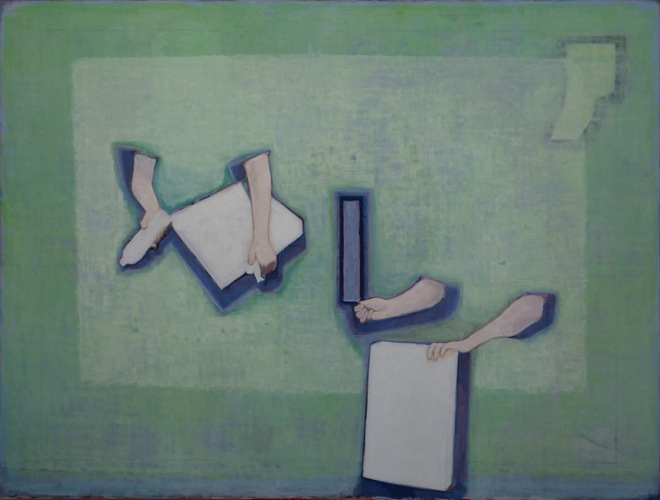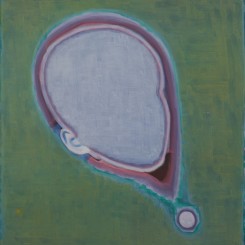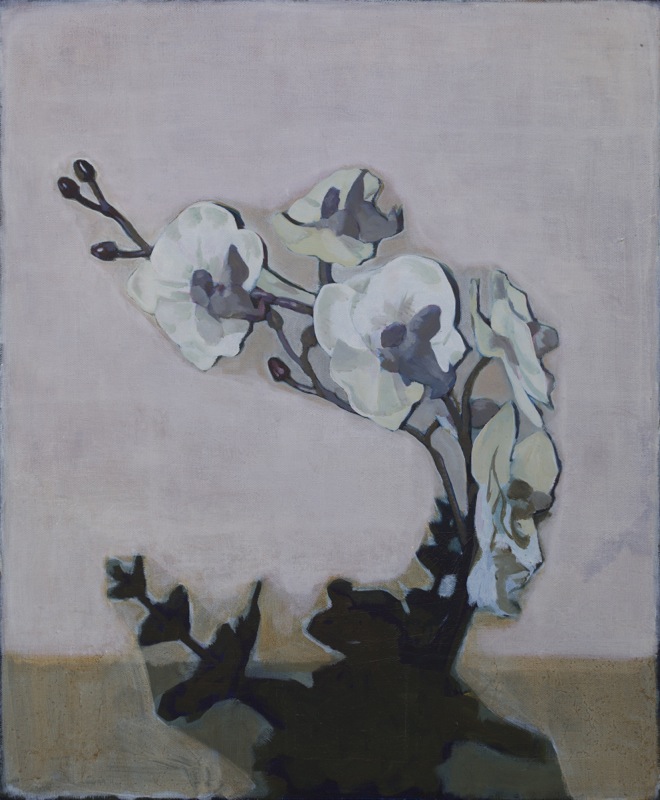“Tang Yongxiang”—Tang Yongxiang solo exhibition
Magician Space (798 East Road, 798 Art Zone, 2 Jiuxianqiao Road, Chaoyang District, Beijing 100015) Jan 11 – Mar 9, 2014
“…However you may paint it (an object), it will never quite be enough.” The most compelling aspect of Tang Yongxiang’s work is the conscious inadequacy which infects it. The paintings pleasantly crowded into Magician Space—though they are not quite equal in effect—seem to hum around this central want, making something distinctive from it.
Interviewed by this writer in June 2012 (to coincide with his first solo exhibition at the now-defunct gallery Hemuse in Beijing), Tang talked of trying to empty himself of education, emotion and ideas—of using “My own very stupid, slow method to discover new kinds of…relationships in my painting. I face a blank canvas, usually without…any idea… I don’t want to be purposeful.” Tang often leaves paintings for so much as a month before returning to work on them, and sometimes abandons them completely.
His work can be called abstract in that it is not directly representational. But it does not conform to the sort of abstract impulse seen now amongst several artists in Beijing, wherein optical patterns and repetition predominate. Tang’s is another kind of abstraction; his paintings conjure the perception of reality—for instance a profile, movements (“Four Hands and A Few Blocks of White”, 2013), or a single object – “Like an Orchid” (2013)— apparently through a process of elimination or stripping down rather than the construction of a complete, alternative sensation, like other “abstractions.” These paintings are like hints, cuttings or clues; and somewhat fugitive.
Described most simply, these are flat (non-perspectival) fields of paint, the surface of which is usually blanched by a white layer that renders the under or overlying colors pastel-like or creamy in tone. The direction of short brush strokes applying this layer has a slightly woven, painterly effect which indicates the accumulated nature of these grounds and the artist’s returning hand; this is particularly visible, for example, in “Like Five Flowers” (2013). Into these fields—for they lightly recall color-field paintings—come fragments of objects, shapes or bodies. These are positioned often in uncanny, odd ways. In “Hand with Pink Trousers” (2013), a pair of legs is isolated and rotated through 180 degrees; a forearm clutching paper beside them floats against light blue, and a thick line extends from one trouser pocket to curve round in the center of the canvas. The line ends by itself, as if having reached a suitable place to stop (many of the works have this same, intuitive feel). Elsewhere, in “Blue Background with a Few Profiles” (2013), several heads are upside down in various states of detail—some are blank, one bears the beguiled smile of a woman. What looks like a naked breast is below right, and on the left side of the canvas, tiny slivers of shape as if cut by the edge of a photograph—hints at a situation of which these fractions could have been part.
At its most successful, Tang’s work is able to evoke the way vision itself is already abstract and ephemeral, often lacking a focal point. One takes his recent output to be as much about what he has dropped as about what is retained in these paintings through a process of selection and the embrace of absence. There is an idiosyncratic sense of balance and accident, for example in the extension of a bald line in space or a group of feet and legs stepping past in “Three Pairs of Legs and One Foot Walking On A Light Green Background” (2013). The works’ titles share a pleasant, disconnected clarity: “Above is the Leg, Below is the Back – 3” (2012). Alongside these ruptures there is, also, a temporal aspect to Tang’s painting- physically in terms of a method where a painting is begun, perhaps left, and resumed. They are marked by both the instant and by lapses of time—itself, of course, a great abstraction.
In sum, these paintings are distinctive, propelled by Tang Yongxiang’s sensibility and technique. They deal with abstraction as a lack of representation in a particular way to generate a positive, fruitful perspective—and not by dispensing entirely with the sight of real objects. The result is a solid exhibition of an unfolding approach, and one looks forward to the development of Tang’s work.

Tang Yongxiang, “Four Hands and A Few Blocks of White”, oil on canvas, 150×200cm, 2013
唐永祥,《四只手和几块白色》,布面油画,150×200cm,2013



